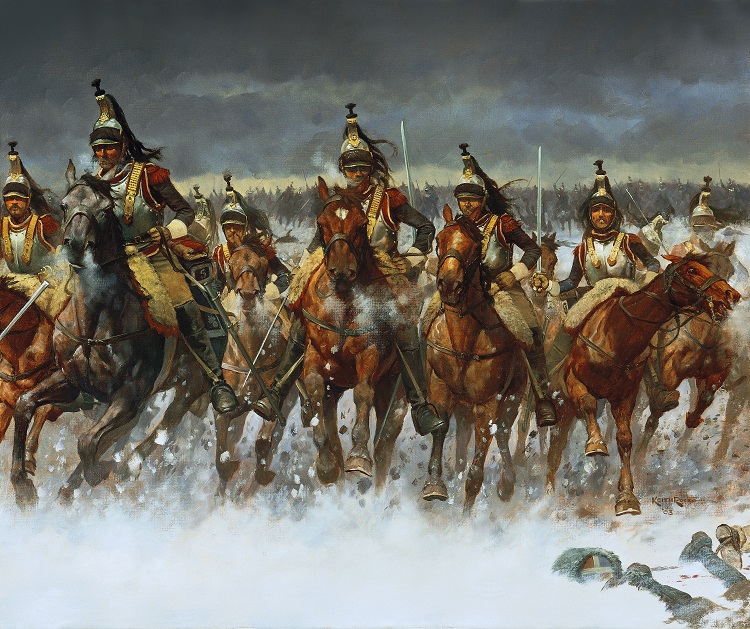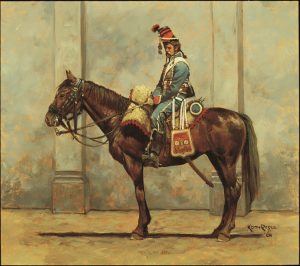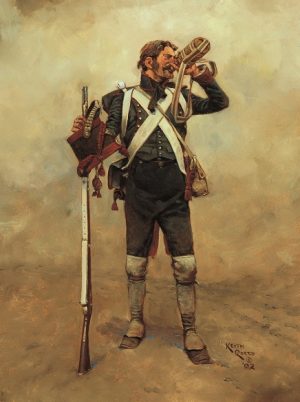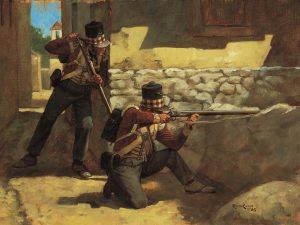Charge of the Cuirassiers at Eylau-1807
Description
200 signed and numbered prints
None of the great Napoleonic struggles is surrounded with more doubt and uncertainty than the battle of Eylau. Fact, myth and propaganda are almost inextricably intertwined, and different authorities give conflicting interpretations of almost every aspect and state of the struggle. That is was a holocaust, fought under almost impossible weather conditions, all agree.
There is some doubt as to which side actually discharged the first shot, but it would seem that the Russians opened fire at eight in the morning, pouring a hail of round shot into the town of Eylau. The French gunners were not slow in making reply, and soon a full-scale bombardment was in progress, although the din was greatly muffled by the falling snow.
Half an hour after the opening of the bombardment, Napoleon ordered Soult and Lasalle to make a threatening demonstration against the Russian right in an attempt to draw Bennigsen’s attention away from his left flank, where in the stillness of time the main French blow would be delivered. A desperate struggle developed, most of Soult’s men being driven back toward Eylau.
The situation on both flanks was soon far from Napoleon’s liking. Napoleon ordered Augereau’s corps to advance without delay against Tolstoi’s positions and create a diversion.
Without a demur, the gallant though ailing Augereau set off to carry out his mission. The VIIth Corps (some 9,000 strong) swept forward into a raging blizzard of snow. All sense of accurate direction was lost. Augereau’s men veered away from their designated objective, Tolstoi’s divisions, and made straight for the center of Sacken’s position, where the gaping muzzles of the Russian 70-gun battery waited to receive them. As the French unwittingly marched to their doom, they also came under fire from the blinded French artillery, and then, shortly after 10:00, the Russian guns opened up. Shot and shell tore remorselessly into Augereau’s troops at point-blank range, inflicting frightful causalities.
As the minutes passed, the situation continued to deteriorate. Doctorov’s reserve infantry fell with the bayonet on Augereau’s shattered units and drove them back.
Another column of Russian infantry, between four and six thousand strong, penetrated into the very streets of Eylau itself, and at one point were dangerously near to the Emperor and its staff, who had been using the church bell tower as a vantage point.
Alarums of this type were sufficient to prove the weakness of the French center and the peril in which it stood, and it behooved Napoleon to resort to an extreme expedient to retrieve the situation. Apart from his jealously conserved Guard, the only men still available were the 10,700 troopers of Murat’s cavalry reserve. These were now ordered (at about 11:30 a.m.) to take position in the shattered French center and charge the looming Russian columns.
Nothing could have been more to the taste of the dashing Murat. In marvelous fettle 80 squadrons of splendidly accoutered horsemen swept forward over the intervening 2,500 yards. It was one of the greatest cavalry charges in history. Driving forward, the two cavalry wings crashed through the serried ranks of Sacken’s center, pierced them, re-formed into a single column once more in the Russian rear, and then plunged back the way they had come through the disordered Russian units to cut down the gunners who had done so much harm to Augereau’s men.
For a lost of 1,500 men, Murat had won Napoleon a vital respite in the center, but even more important, the gallantry and effectiveness of this attack put fresh heart into the tiring French infantry. Napoleon had good cause to be grateful to his cavalry arm, which now, perhaps for the first time in the history of the Grande Armee, came indisputably into its own as a finely tempered and practically irresistible battle weapon.
Additional information
| Medium | |
|---|---|
| Size | 11" x 14", 20" x 24" |
| Type |





